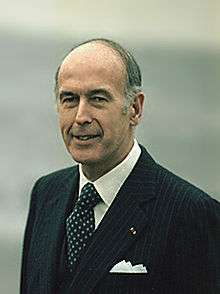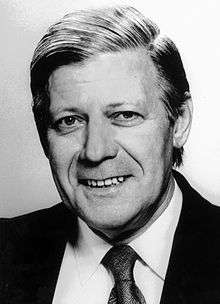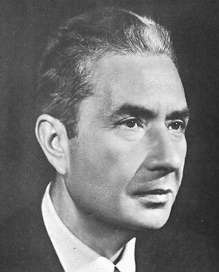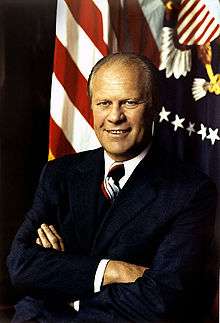2nd G7 summit
| 2nd G7 summit | |
|---|---|
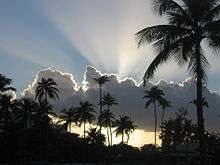 Sunset in San Juan, Puerto Rico | |
| Host country | United States |
| Dates | June 27–28, 1976 |
| Follows | 1st G6 summit |
| Precedes | 3rd G7 summit |
The 2nd G7 Summit was held at Dorado, Puerto Rico between June 27 and 28, 1976.[1] The venue for the summit meetings was the Dorado Beach Resort, which is near San Juan, Puerto Rico.[2]
The Group of Six (G6) was an unofficial forum which brought together the heads of the richest industrialized countries: France, West Germany, Italy, Japan, the United Kingdom and the United States; and the Group of Seven (G7), meeting for the first time this year, is formed with the addition of Canada.[3] This summit, and the others which would follow, were not meant to be linked formally with wider international institutions; and in fact, a kind of frustrated rebellion against the stiff formality of other international meetings was an element in the genesis of cooperation between France's President and West Germany's Chancellor as they conceived the first summit of the G6.[4]
Leaders at the Summit
The G7 is an unofficial annual forum for the leaders of Canada, France, West Germany, Italy, Japan, the United Kingdom and the United States.
The 2nd G7 summit was the first summit for British Prime Minister James Callaghan and Canadian Prime Minister Pierre Trudeau as it was formed with the addition of Canada. It was also the last summit for Italian Prime Minister Aldo Moro, Japanese Prime Minister Takeo Miki and U.S. President Gerald Ford.
Core G7 participants
These summit participants are the current "core members" of the international forum:[5]
| Core G7 members Host nation and leader are indicated in bold text. | |||
| Member | Represented by | Title | |
|---|---|---|---|
| |
Canada | Pierre Trudeau [1] | Prime Minister |
| |
France | Valéry Giscard d'Estaing [1] | President |
| |
West Germany | Helmut Schmidt [1] | Chancellor |
| |
Italy | Aldo Moro [1] | Prime Minister |
| |
Japan | Takeo Miki [1] | Prime Minister |
| |
United Kingdom | James Callaghan [1] | Prime Minister |
| |
United States | Gerald Ford [1] | President |
| |
European Commission | Roy Jenkins [6] | President |
Issues
The summit was intended as a venue for resolving differences among its members. As a practical matter, the summit was also conceived as an opportunity for its members to give each other mutual encouragement in the face of difficult economic decisions.[4]
Gallery
See also
Notes
- 1 2 3 4 5 6 7 8 Japan, Ministry of Foreign Affairs (MOFA): Summit Meetings in the Past; although this article is named "2nd G7 summit" because it is the second in a series of summits which will become continuing, it is actually the first time that the G7 meets
- ↑ US Embassy in Japan: Chronology, June 1976; Shabecoff, Philip. "Go-Slow Policies Urged by Leaders in Economic Talks; Closing Statement Calls for Sustained Growth Coupled With Curbs on Inflation; Ford's Aims Realized; 7 Heads of Government Also Agree to Consider a New Body to Assist Italy Co-Slow Economic Policies Urged by 7 Leaders," New York Times. June 29, 1976; excerpt, "SAN JUAN, P.R., June 28 President Ford and six other leaders of industrial democracies announced here today that they had agreed to pursue the objective of sustained economic growth.... The leaders met at the palm fringed Dorado Beach Resort near here."
- ↑ Saunders, Doug. "Weight of the world too heavy for G8 shoulders," Globe and Mail (Toronto). July 5, 2008 -- n.b., the G7 becomes the G8 with the inclusion of Russia starting in 1997.
- 1 2 Reinalda, Bob and Bertjan Verbeek. (1998). Autonomous Policy Making by International Organizations, p. 205.
- ↑ Rieffel, Lex. "Regional Voices in Global Governance: Looking to 2010 (Part IV)," Archived June 3, 2010, at the Wayback Machine. Brookings. March 27, 2009; "core" members (Muskoka 2010 G-8, official site). Archived June 3, 2010, at the Wayback Machine.
- ↑ MOFA: Summit (8); European Union: "EU and the G8" Archived February 26, 2007, at the Wayback Machine.
References
- Bayne, Nicholas and Robert D. Putnam. (2000). Hanging in There: The G7 and G8 Summit in Maturity and Renewal. Aldershot, Hampshire, England: Ashgate Publishing. ISBN 978-0-7546-1185-1; OCLC 43186692
- Reinalda, Bob and Bertjan Verbeek. (1998). Autonomous Policy Making by International Organizations. London: Routledge. ISBN 978-0-415-16486-3; ISBN 978-0-203-45085-7; OCLC 39013643
External links
- No official website is created for any G7 summit prior to 1995 -- see the 21st G7 summit.
- University of Toronto: G8 Research Group, G8 Information Centre
.jpg)
